Reverse Hexes
- Eon
- Mayfair
- Internet variations
Eon Hex Rules
GAS GIANT: This is the hex with one big planet.
At the start of the game, place all 20 of your tokens on the Gas Giant. During play you move them off of the planet normally. When challenged at home you may, once during the challenge after alliances have been declared and before cards are played, withdraw as many tokens as you wish as long as you leave at least one token as your defending force. You must move the tokens you choose to withdraw away from the cone to the opposite end of the Gas Giant to clearly signify their neutrality Thus, your tokens "on the planet" after withdrawal can be any number down to one. If you have no tokens on the Gas Giant, you lose the use of your alien power until you regain a base there. In this case, you defend with a force of zero just as you would in a game with regular hexes.
Note: The Gas Giant is immune to all planetary cataclysms eg. those perpetrated by the Moon Wraith, the Wild Loser, the Wild Demon, Eviction Moon, etc. Also, do not use in a game with the Filth or the Terrorist. and do not use in a two player game. The Gas Ginat player can not begin the game as the Sniveler.
| 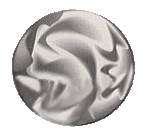 |
PULSAR: This is the hex with a Plus sign and a Minus Sign.
Start the game by placing tokens as you wish on your planets as long as you place at lest one on each planet. Whenever you are challenged on a planet in your home system, unless you are silenced, you must declare (before the offensive player puts tokens into the cone) whether the winner, if an Attack card is played, will be the player with the higher total or the player with the lower total. Unless prevented by the Silencer, Will, etc., you also choose which planet must be challenged as long as the offensive player does not already have a base there. Your statement of Attack win conditions changes the normal win conditions even if you do not have a token on the challenged planet. If the Anti-Matter is a main player, you may not "pulse high".
| 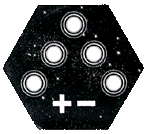 |
SPIRAL: This is the hex with the planets forming a spiral configuration.
At the beginning of play, place your tokens as you wish as long as you place at least one token on each planet. As defensive player, whenever you defend a home system planet on which you had tokens at the start of the challenge, whether you win or lose, you get a "reward" of one of more cards from the deck and/or tokens from the Warp to bases (or from the Praw to the Warp) corresponding to the number printed on the planet you are defending. You get this "reward" immediately after the outcome is determined. If you get cards, they are subject to the Extortionist.
|  |
SIX-PACT: This is a hex with six planets on it.
At the beginning of play, place your tokens as you wish as long as you place at least one token on each planet. You lose the use of your alien power if you lose four of your home bases. Once you have drawn your Alien Power(s), draw six more Alien Powers at random and place each of these behind a planet as a specific "planet power". When you are defensive player in a challenge on a planet in your home system (if the offensive player has not declared a moon challenge) before the offensive player places tokens into the cone you: 1) choose which of your planets will be the defensive planet (as long as the offensive player does not already have a base there) unless otherwise prevented, e.g. by the Silencer, Will, etc, and 2) for the duration of the challenge have the planet power of the planet which is being challenged instead of your own Alien Power(s). When you lose a defensive challenge on a planet in your home system, you lose the planet power, but not until the end of the challenge in which it was used (unless Zapped, of course). Therefore, if you lose such a challenge and thus a base, you may still exercise your planet power if it affects the outcome of the challenge, e.g. the Judge's judgement, but after the challenge you lose the use of that power for the rest of the game. Note: when using planet powers which call for beginning-of-the-game effects, e.g. Miser and Schizoid, set those effects at the beginning of the game as you would ordinarily. These effects will only be used, however, when that particular power is being used.
| 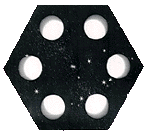 |
At all times when you are not defending a home base where you have a planet power, you have your main Power(s) or you may choose instead to have one of your planet powers (any which has not been lost) after which at the end of the challenge that planet power is permanently lost. For purposed of identification you are considered to "be" the alien you are currently using. If you do not specify a particular planet power, you will be considered to be your main Alien Power(s). Do not use Warpish as any of your powers.
SPACE DUST: This is a hex with no planets, just a star field.
Initially, place all 20 of your tokens and three of your four Star Discs on your Planet Hex (the fourth Star Disc is the one with the "reverse cone" sticker on it. It goes into the Destiny Pile). Each token (and Star Disc) you have on your hex counts as a planet base for you, even though there are no actual planets there; and, if you remove a token or Star Disc that planet base disappears from your hex. You move your tokens and Star Discs onto and off of your hex normally (as if it were one big planet). But; 1) if you have no home bases as described above (neither tokens nor Star Discs on your hex) you lose your Alien Power; and 2) if you have no home bases, you can not place a new token onto your hex when released from the Warp, returning from an alliance, etc. When you are the defensive player on Space Dust, the offensive player picks one of your tokens (or Star Discs) to challenge (as if it were a planet). Your defending token value in such a challenge is one, unless a Star Disc is challenged which has a value of ten (see below). If you have no tokens on your hex, only then may you be challenged there as though you had a planet base with no tokens.
| 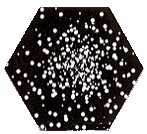 |
Whenever another player is entitled to establish a base on your hex as a result of an interaction (bested you in an Attack, made a deal, etc), he or she simply stacks their tokens on top of one another and places them onto your hex as a base. Any other players (allies, wild Force, etc.) also entitled to a base do the same with their tokens. On susbsequent challenges, each base is established in this manner. Each stack of one or more tokens counts as a separate base. Your Star Discs on your hex are treated as any other token except: 1) in an Attack they are worth ten rather than one, even if you are the Macron (but twenty if the Mini Mac Moon is in effect); 2) you may only move one Star Disc token into a challenge; 3) any Star Disc token which should go to the Warp immediately enters the Destiny Pile discard stack instead and is shuffled into the new pile when the existing pile is used up; and 4) when you establish a base on another player's hex with a Star disc token, it may not be moved again except to go to the Destiny Pile (in lieu of going to the Warp for any reason). Items normally kept on a Star Disc, i.e. Lucre, "Assessed" tokens, etc. are kept just off the hex and are treated as if they were on a Star Disc. As an Amoeba playing this hex, you may ooze to defend but must disperse "dust to dust" after the challenge. The player of this hex can not use Moon Boon.
PRAW: This is the hex with the warp, and smaller reverse warp.
When the number of tokens in the Warp reaches or surpasses "critical mass" (the number of players times three), all tokens in the Warp descend into the Praw (Aieeee!). Before each of your Destiny Pile flips, as a reward for a successful alliance, when you buy tokens back with Lucre, and when you are otherwise authorized to release a token from the Warp, you may elect to release a token from the Warp, or elect to raise a token from the Praw back to the Warp, but may make only the total number of these token moves authorized. A Mobious Tubes or Warp Break may used to release tokens from the Warp or the Praw directly back to bases, but not to release both.
|  |
Mayfair Hex Rules
Also in .doc format
BINARY: Two suns, five planets.
When setting up at the beginning of the game, the Binary player distributes his tokens among his five planets however he wishes. When determining alien Powers, the Binary player draws two Flare Cards, assigning one power to each star. From this point on, the Binary player can use either power, but not both on the same challenge.
If the binary player loses two bases, he loses the use of a power, but the other is unaffected. For the Binary player to lose both of his powers, he would have to be reduced to two bases.
BINARY: (Variant) Two suns, eight planets
When setting up at the beginning of the game, the Binary player distributes his tokens among his eight planets however he wishes. When determining alien Powers, the Binary player draws two Flare Cards, assigning one power to each star. From this point on, the Binary player can use either power, but not both on the same challenge. When the binary is challenged, he or she must use the power(s) of the base attacked.
If the binary player loses Three bases in either of his system, he loses the use of the corresponding power, but the other is unaffected. For the Binary player to lose both of his powers, he would have to be reduced to one base or no base on each system.
|  |
RINGS: Planet with four rings
The central planet and each of its four rings count as separate planets. When setting up, distribute your tokens however you wish among the rings and central planet. The rings and central planet have special defensive characteristics, namely, the outer ring adds two to the defense, the second outermost ring adds four, the second from the planet adds six, the inner ring adds eight, and the central planet adds ten.
The Rings player can subtract these values instead of adding them at his option.
|  |
WORLD SHIPS: Five rocketing planets
After shuffling the Destiny pile, deal three Destiny Cards to the Worldships player, who keeps them as a separate hand, immune from consolation or other incursions. The Worldships player can use one of these cards to override a card turned up from the Destiny pile to divert an attack from himself or to redirect his own attack. If it is a wild card, the Worldships player decides the color. Both Destiny Cards then go to the discard pile.
When the Destiny Pile is exhausted, the worldships player discards any unused Destiny Cards and draws three new ones from the reshuffled deck.
The Worldships player has no effect on the Will.
| 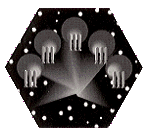 |
ROSETTE: Six planets
Place your 20 tokens on the planets in any combination. When challenged, the Rosette player can use his tokens on the two adjacent planets to compute the outcome of the challenge. These tokens are not at risk, and they are added in after cards are revealed and after all other effects are computed. The rosette player cannot use an adjacent planet if he does not have a base there.
The rosette player does not have to add his tokens from adjacent planets, as when opposing Anti-Matter, and in fact can evacuate the tokens from the challenged planet to an adjacent planet if he has a base there.
When trying to regain a planet in his own system, the Rosette player can use his tokens on planets adjacent to the one he is challenging to compute the winner of the challenge. As when he is defensive player, the Rosette player does not put these tokens at risk.
| 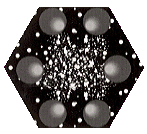 |
Gas giant
During setup, place all 20 tokens on the planet. When Gas Giant is
challenged, begin the challenge normally until allies have committed
themselves. Then the Gas Giant may withdraw tokens from the
challenge to the other side of the planet, leaving at least one token
in the challenge. The withdrawn tokens are no longer involved in the
challenge. Other players stack their tokens on the Gas Giant to
indicate a base, and they may have multiple bases on the Gas Giant.
The Gas Giant player must have at least three tokens on the planet to
retain his Alien Power.
Gas Giant is immune to planetary cataclysms such as Wild Loser and
Eviction Moon. For Sniveler, consider Gas Giant as three home bases.
Do not use in a game with Terrorist nor in a two player game.
Isolated
Set up as per a normal hex. Whenever a challenge is made against a
planet or moon in your system, all other players are limited in the
number of tokens they may commit to the challenge. Offensive players
may put at most two tokens on the hyperspace cone, and allies may
commit at most one token. You may place tokens on the cone normally.
In addition, whenever another player must return tokens to bases, he
may place at most one token in the Isolated system unless it contains
his only base.
lunacy
At game setup, draw five moons and place them over the moons on the
Lunacy hex. Do not use any moon that causes itself to be moved.
Place your tokens as you wish on the moons and central planet. The
moons count as planet bases in all respects, and you lose your Alien
Power if you have tokens on less than three of them.
The moons' special effects are used like normal moons except that:
the moons are considered secret until an occupying player or yourself
decides to play them; no moon-related effects (like Sanity, Vanish
Moon, and Moon Win) apply to your moons; and one-shot moons are not
discarded but may only be used once per game.
ringworld
Set up by placing two tokens on every other segment of the outer
ring. (The inner ring is not used for game purposes.) You retain
your Alien Power as long as you have any tokens on the Ringworld, and
each segment is considered a planet base.
When returning tokens, you may place tokens on any segment regardless
of if a token is already there. Whenever defending a segment,
immediately after the cone is pointed, you may move tokens between
the selected segment and the two adjacent segments, possibly vacating
the attacked segment.
Pulsar
Set up as a normal hex. As soon as the Pulsar player is determined
as defensive player and is defending a home planet base, you may
declare whether the high total or the low total will win in the
challenge. You may also choose which planet base is attacked as long
as the offensive player does not have a base there.
Do not use with Loser or other Powers that have the same effect.
Alien Powers take precedence over the Pulsar hex in determining which
planet is attacked (for example, when Will is the offensive player).
Binary lunacy
Binary Lunacy combines the Binary and Lunacy system hexes. The
effects of both hexes are present with the following augmentations:
- Draw six moons, enough to cover each moon in the system.
- The Binary Lunacy player loses a star system power when he is
reduced to two or fewer bases on the appropriate side.
Space dust
Scatter your tokens on your hex during game setup. Each token counts
as a planet base for you even though there are no planets. You may
move tokens freely on or off of your hex normally as if it were one
big planet. If you have no tokens in your system, you lost your
Alien Power and you may not place tokens into your system. When you
are defensive player, the offense chooses a token to attack. Players
that gain a base in your system stack their tokens and place them in
the Space Dust to indicate a planet base.
In addition, you are given three of your four Destiny cards
(including the reverse card) during game setup. As a defensive
player, you may play a Destiny card when Kickers are played to add
five to your total in the challenge. The card is placed in the
Destiny discard pile.
six-pact
During game setup, place tokens as you wish on the six planets. You
lose your Alien Power when you have tokens on two or fewer home
bases. Then draw an Alien Power for each planet in addition to your
normal power.
As soon as you are determined as defensive player on a planet base,
you may choose the defending planet before the offense places his
tokens. For the duration of the challenge, you use the
"planet power" in place of your normal power. When you
lose a defensive challenge in this way, you lose the associated Alien
Power at the end of that challenge.
At all other times, you may use your normal power or a planet power,
but using a planet power in this situation causes it to be lost at
the end of the challenge.
When using a power with game setup effects (such as Miser or
Schizoid), set these effects at the beginning of the game but only
use the effects when the associated power is in use.
singularity
Tokens not belonging to the Singularity player lost in his system do
not go to the Warp, but rather into the Singularity. The total
number of tokens lost determines which section of the Singularity: if
one token is lost, it goes in the portion labelled 1, two go to 2,
etc. Every time the Singularity player's color is flipped in the
destiny pile, move tokens from the end of the Singularity to the Warp
and move all other tokens up one level towards the Warp.
You may offer to release tokens from the Singularity to the Warp or
to bases as part of a deal.
Warp-related powers such as Healer and Zombie do not affect tokens
lost to Singularity but can be used when tokens are pushed from
Singularity to the Warp.
Spiral
At the beginning of play, arrange your tokens however you wish as
long as there is at least one token on each planet. As defensive
player, whenever you defend a planet base, regardless of whether you
succeed or not, you gain rewards as a defensive ally (cards from the
deck or tokens from the warp) corresponding to the number on the
planet. These rewards are treated exactly like defensive allies'
rewards for purposes of gameplay.
Space stations
At game setup, place two tokens on each space station and the
remainder on the central planet. Each space station and the central
planet count as a separate planet base for game purposes, and if you
have tokens on less than three of them, you lose your Alien Power.
During play, each station may have at most two tokens on it. A
station may be attacked with more than two tokens, but if the
offensive player wins, he chooses two tokens to arrive on the station
and the rest return to bases.
Whenever you attack or defend the central planet, you may count all
of your tokens on stations towards the total; these tokens are not at
risk and are not considered part of the challenge. Also, as long as
you have tokens on the central planet, you may at the beginning of
your turn arrange your tokens however you wish among the planet and
the stations where you have bases.
Internet Hex Rules
Copyright (C) 1991 by Ken Cox. Distributed as Freeware. Permission is given to copy, modify, and distribute this material freely provided this notice is retained.
WARPISH: This is the hex with five planets orbiting a Space Warp.
You may use this hex when you have the Warpish Power. The hex has been introduced largely to prevent the occasional problem where tokens IN the Warp drift ONTO Warpish planet bases and vice-versa. (Of course, sometimes that's half the fun....)
| 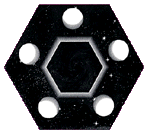 |
SPACE STATIONS: This is the hex with a central planet and six space stations.
At the start of the game, place two tokens on each space station and the remaining eight on the central planet. Each station and the central planet counts as a separate planet for game purposes, and you lose the use of your Alien Power if you have tokens on less than three of them.
During play, each station may have at most two tokens on it. A station may be challenged with more than two offensive tokens, but if the offensive player wins you select two of the tokens to arrive on the space station and the rest return to bases. No player (including yourself) may add tokens to a space station that already has two tokens.
Whenever you attack or defend your central planet, you may count all of your tokens on the space stations toward your total as if they were your allies; however, you do not get ally rewards for these tokens, and they are not affected by the challenge outcome.
| 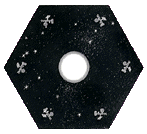 |
In addition, provided you have a base on your central planet, before the start of each challenge you may rearrange your tokens freely among the central planet and those space stations where you have bases. You are subject only to the rule that you not add tokens to a station that already has two tokens.
Comment: The central planet is very strong defensively. The stations are weaker, but the offensive player will generally not invite allies (and even if he does, they probably won't accept) so the situation is not that bad.
LUNACY: This is the hex with a central planet and five crescent moons.
[ Variant: Two planets and six moons. ]
At the start of the game draw five Moons at random and place them on the crescents. Do not use Moon Boon, Moon Wraith, or any other Moon whose effect causes it to be moved. Place your tokens as you wish on the central planet and Moons. [ With the variant hex, draw six Moons and place tokens as you wish. ]
The central planet and each Moon count as a planet for game purposes, and you lose the use of your Alien Power if you have tokens on less than three of them. [ With the variant hex, if you have tokens on less than four of them; OR, if you have no tokens on the two planets -- decide which before starting play. ]
Your Moons are treated as regular Moons except for the following:
|  |
1) Bases on your Moons count as planet bases for a win, and for the use of Powers (e.g. the Plant), Flares, Edicts, etc..
2) No Moon-related effects (Sanity, Vanish Moon, Moon Win, Wild Disease "discard a Moon", etc.) apply to your Moons.
3) All your Moons are treated as Secret; their effects do not occur until the occupying player OR YOU reveal them. Thereafter they are treated as Continuing Moons (their effect can be used only once per challenge), except that if you re-occupy a Moon you may conceal it again without its effect occurring.
4) Moons that say "discard after use" are not discarded when used, but the effect cannot be used again during the game.
Note on rule 3: Only you or a player who actually occupies a Moon can invoke its effect. Thus, you can keep tokens on (for example) the Null Moon without problems, but if another player takes over the Moon you can reveal it and he suffers from the effect. You may re-take the Moon without losing your power (per the rule, you may conceal it upon re-occupying it).
Also note that your Moons are challenged and occupied as Moons; i.e., no alliances are allowed in the challenge, you do not play a card to defend the Moon if it is unoccupied, any player who flips your color may challenge any other player on one of your Moons, occupancy cannot be granted in a deal, and so on.
If you are playing with Moons, you get the appropriate number of additional Moons which are treated according to the Moon rules.
Comment: We haven't actually tried this one. The above version of the rules is based on play-testing reported by another group, and I'm not sure I got all the details right.
You may also wish to use the 2 planet (6 moon) Lunacy as a Binary Lunacy (See rules on Binary system).
SINGULARITY: This is the hex with six planets and a trumpet-shaped Singularity.
The Singularity is divided into ten numbered levels. The disc-shaped portion of the Singularity has no effect on play. [ An alternate version has differently-numbered levels -- see below. ]
Set up by arranging your tokens as you wish on your planets. You lose the use of your Alien Power if you have tokens on less than three planets.
Whenever a planet or Moon in your system is the target of a challenge, any tokens other than your own that are lost in the challenge go to the Singularity instead of the Warp. Your own tokens go to the Warp. The number of tokens lost determines where the tokens are placed. If one token is lost, it is placed in the level labeled 1, if two are lost they go in the level labeled 2, and so on; if ten or more are lost, they go in the level labeled 10+. [ The highest label on the alternate hex is 5+. ]
At the start of each player's turn all tokens in level 1 of the Singularity are released and go to the Warp (Zombie tokens return to bases). Tokens in the lower levels each move up one level (those from 2 go to 1, those from 3 to 2, etc.). [ On the alternate hex, do the same thing but ignore the labels (some levels are not labeled). Tokens are still released from the topmost level. ] [ Variants: do the move only when your color is flipped; do the move at the start of each challenge; tokens at the top level return to bases instead of the Warp. ]
| 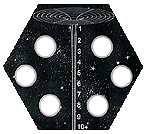 |
As part of a deal you may move a player's tokens up any number of levels in the Singularity, or release them to the Warp or to bases.
Mobius Tubes and Warp break do not affect the Singularity. Warp-related powers such as the Healer and Zombie do not apply to tokens lost to the Singularity; tokens adhering to the Fungus continue to adhere in the Singularity.
Comment: We (and other groups) have tried this with a few variants, and the above seems appropriate. Releasing tokens to bases, or moving them up once per challenge, cuts back on the fear factor; the idea is that the system should act like a short-term Void and people would be reluctant to commit a lot of tokens to the attack. The alternate hex increases this by changing the labels to conform more with the number of tokens typically lost in a challenge, thus:
| Original label | 1 2 3 4 5 6 7 8 9 10+ |
| Alternate label | 1 2 3 4 5+ |
ISOLATED: This is the hex with five planets whose background depicts only a few scattered galaxies.
Set up with four tokens on each planet. You lose the use of your Alien Power if you have tokens on less than three planets.
Whenever a challenge is made against a planet or Moon in your system, players other than yourself are restricted in placing tokens into the Cone. The main player may put at most two of his tokens into the Cone; an ally (on either side) may put at most one. You may place tokens in the Cone normally. This restriction applies to ALL placement of tokens in the Cone, including Amoebic oozing, Super Parasite, etc.
In addition, whenever other players must return tokens to bases from the Cone or Warp, at most one token may return to a base in your system. All other tokens must if possible return to bases outside your system. Only if a player has no bases outside your system may he return more than one token to your planets.
Comment: The idea is that he's WAY out there and everyone else has a great deal of trouble getting there. Defensively it's very good; also, the bases that other players get in the system are very weak and can't be reinforced rapidly, making them prime Assassin-Bully fodder.
| 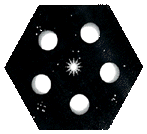 |
RINGWORLD: This is the hex with a central sun encircled by a Ringworld.
The Ringworld is divided into ten segments, delineated by the light-dark alternations and the dotted lines. The inner ring of shadow squares is not used for game purposes. [ Variant: the Ringworld may be divided into any even number of segments by changing a print option. Rule suggestions are not provided for these variants. ]
Set up by placing two tokens on each of the ten segments of the Ringworld. Each of the segments counts as a separate planet for game purposes; you retain your Power as long as you have any tokens on the Ringworld.
When you return tokens to bases, if you have a base on the Ringworld you may place tokens on any Ringworld segment, even if you have no base on that segment. This ability does not apply to other players' tokens.
Whenever you are defending any segment, immediately after the Cone is pointed at the segment you may move tokens between that segment and the two adjacent segments. You may remove any or all of your tokens from the challenged segment to the adjacent segments, or you may add more tokens to the challenged segment from the adjacent segments (even if you had none there to begin with). You may also remove some tokens and add others, e.g. if you are the Fungus and your tokens have different values.
|  |
Tokens belonging to other players may not move from segment to segment; each separate segment counts as a different base for other players.
Comment: Combines some aspects of Space Dust (ability to return anywhere, lose power only if you lose all bases) with some of Gas Giant (the ability to choose, in a limited fashion, the number of tokens that will defend).















